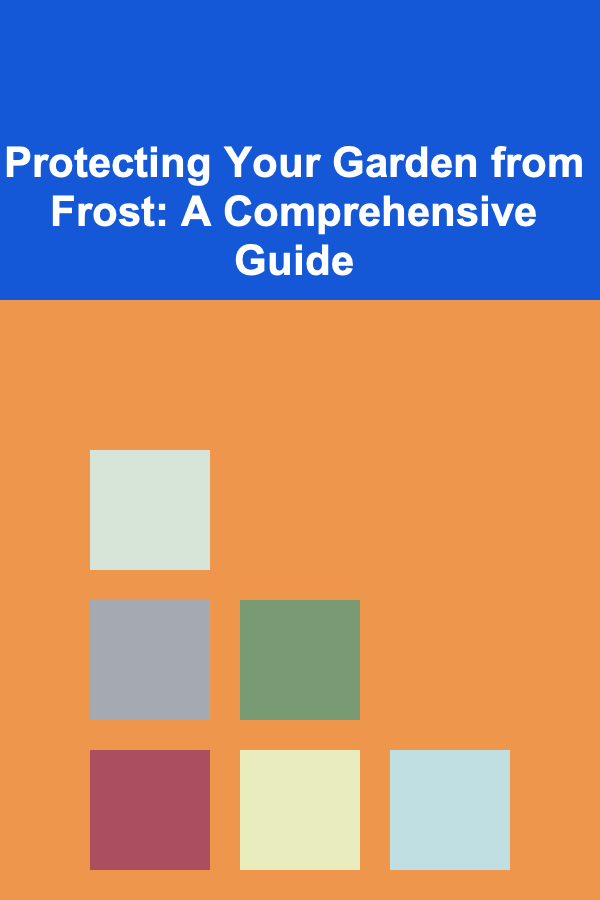
Protecting Your Garden from Frost: A Comprehensive Guide
ebook include PDF & Audio bundle (Micro Guide)
$12.99$8.99
Limited Time Offer! Order within the next:

Frost, the delicate yet destructive kiss of winter, poses a significant threat to gardens worldwide. Understanding frost and its impact, along with implementing effective preventative measures, is crucial for ensuring the survival and continued productivity of your cherished plants. This comprehensive guide delves into the science of frost, identifies vulnerable plants, and provides a range of proven strategies for protecting your garden from its damaging effects.
Understanding Frost: A Gardener's Nemesis
Frost occurs when the air temperature drops below freezing (0°C or 32°F), causing water vapor in the air to condense and freeze on surfaces. This phenomenon, known as deposition, results in the formation of ice crystals that we recognize as frost. However, the damage caused by frost is not simply due to the ice itself. It's the formation of ice within the plant tissue that causes the most significant harm.
The Science Behind Frost Damage
As temperatures plummet, water within plant cells begins to freeze. This process draws water out of the cells, leading to dehydration. Simultaneously, the expanding ice crystals rupture cell walls, causing irreversible damage. This cellular damage manifests in various ways, including:
- Wilting: Dehydration leads to drooping and wilting of leaves and stems.
- Discoloration: Affected tissues often turn brown or black, indicating cell death.
- Blistering: Ice crystals can cause blistering on fruits and vegetables.
- Stem Splitting: In severe cases, the expansion of ice within stems can cause them to split and crack.
- Death of Plant Parts: Frost can kill buds, flowers, new shoots, and even entire plants.
Types of Frost: Radiational vs. Advection
Understanding the different types of frost is essential for choosing the most appropriate protection methods:
- Radiational Frost: This is the most common type of frost and occurs on clear, calm nights. The ground loses heat through radiation, cooling the air near the surface. Cold air, being denser, settles in low-lying areas, making these locations particularly susceptible to frost.
- Advection Frost: This type of frost is caused by the invasion of a mass of cold air. It can occur on windy nights and affects a wider area than radiational frost. Advection frosts are often more severe and harder to protect against.
Recognizing the signs of an impending frost is paramount. Pay attention to weather forecasts, particularly for clear, calm nights with little or no wind. Also, be aware of microclimates within your garden; low-lying areas and spots sheltered from the sun are more prone to frost.
Identifying Plants Vulnerable to Frost
Not all plants are created equal when it comes to frost tolerance. Understanding which plants in your garden are most vulnerable is the first step in prioritizing protection efforts. Generally, plants are categorized into hardiness zones, but even within those zones, individual plant species and varieties have varying degrees of tolerance.
Annuals vs. Perennials
- Annuals: These plants complete their life cycle in a single growing season and are generally the most susceptible to frost damage. Examples include tomatoes, peppers, basil, petunias, and zinnias. They are designed to be grown during frost-free periods.
- Perennials: These plants live for more than two years and often have some degree of frost tolerance. However, even hardy perennials can be damaged by severe or late-season frosts, especially new growth. Examples include hostas, daylilies, lavender, and many types of herbs.
Specific Plant Vulnerabilities
Beyond annuals and perennials, certain plants are inherently more vulnerable to frost due to their physiology or stage of development:
- New Seedlings: Young, tender seedlings are extremely susceptible to frost damage. Their delicate tissues are easily damaged by ice crystal formation.
- Flowering Plants: Flowers and buds are often more sensitive to frost than foliage. A late frost can decimate fruit production by killing blossoms.
- Succulents: While some succulents are relatively hardy, many are sensitive to freezing temperatures. Their fleshy leaves retain water, making them prone to cell rupture during freezing.
- Tropical and Subtropical Plants: Plants originating from warm climates are generally not frost-tolerant and require protection in colder regions. Examples include citrus trees, hibiscus, and bougainvillea.
- Late-Season Growth: Unusually warm autumn weather can trick plants into producing new growth that is particularly vulnerable to early frosts.
Carefully observe your plants and note which ones show signs of frost damage first. This will help you prioritize your protection efforts in the future. Keeping a gardening journal can be invaluable for tracking frost events and plant responses.
Frost Protection Strategies: A Toolkit for Gardeners
Protecting your garden from frost requires a multi-faceted approach. The specific strategies you choose will depend on the severity of the frost, the types of plants you are protecting, and your available resources.
1. Monitoring and Forecasting
Staying informed about upcoming frost events is crucial. Utilize reliable weather forecasts, paying attention to specific temperature predictions for your local area. Many weather apps and websites provide hourly forecasts, allowing you to pinpoint the likely onset of freezing temperatures. Remember that local weather patterns can vary significantly, so relying on a hyper-local forecast is best.
Beyond official forecasts, develop an understanding of your garden's microclimate. Observe how temperatures vary in different areas of your yard. Low-lying areas are often colder, while spots near buildings or fences may be slightly warmer.
2. Watering Wisely
While it may seem counterintuitive, watering plants before a frost can actually help protect them. Moist soil retains heat better than dry soil, radiating warmth back into the air and potentially raising the temperature around your plants by a few degrees. Water deeply in the late afternoon or early evening before a predicted frost. Avoid overhead watering, as this can create ice on plant leaves, which can exacerbate frost damage. However, for larger-scale operations, overhead irrigation during a frost event is a viable option. The constant freezing of the water releases heat, protecting the plants. This requires careful monitoring and application.
Important Note: Do not waterlogged soil, as this can lead to root rot, especially during cold weather. The goal is to moisten the soil, not saturate it.
3. Mulching for Insulation
Mulch acts as an insulator, helping to retain heat in the soil and protect plant roots from freezing temperatures. Apply a thick layer of mulch (2-4 inches) around the base of plants, using materials such as straw, shredded leaves, wood chips, or pine needles. Mulch also helps to moderate soil temperature fluctuations, reducing the risk of frost heave, which can damage plant roots by pushing them out of the ground.
Tip: For particularly sensitive plants, consider using a combination of mulch and row covers or other protective structures.
4. Covering Plants: Creating a Protective Barrier
Covering plants is one of the most effective ways to protect them from frost. The covers create a barrier between the plants and the cold air, trapping heat and preventing ice crystal formation. A variety of materials can be used for covering plants, each with its own advantages and disadvantages.
- Row Covers (Floating Row Covers): These lightweight fabrics are made from spun-bonded polypropylene and allow sunlight, air, and water to penetrate. They are ideal for protecting large areas of plants, such as vegetable rows or flower beds. Row covers can be draped directly over plants or supported by hoops to create a mini-tunnel.
- Blankets and Sheets: Old blankets and sheets can provide effective frost protection, especially for larger plants or shrubs. Ensure that the covering extends to the ground to trap heat. Avoid using plastic directly on plants, as it can trap moisture and lead to fungal diseases.
- Burlap: Burlap is a natural, breathable material that provides good insulation. It is particularly useful for protecting trees and shrubs.
- Cloches: Cloches are individual plant covers, often made of glass or plastic. They are ideal for protecting small, vulnerable plants like seedlings or herbs.
- Plastic Sheeting: While less breathable than other options, plastic sheeting can provide effective frost protection if used carefully. Ensure that it does not touch the plants directly and that it is well-ventilated to prevent moisture buildup.
- Cardboard Boxes: Simple cardboard boxes can be used to protect individual plants, especially overnight. Weigh them down with rocks or bricks to prevent them from blowing away.
Important Considerations When Covering Plants:
- Timing: Cover plants in the late afternoon or early evening before the predicted frost. Remove the covers in the morning once the temperature rises above freezing.
- Ventilation: Provide adequate ventilation to prevent moisture buildup and fungal diseases. This is particularly important when using plastic covers.
- Support: Use stakes or hoops to support covers and prevent them from crushing plants.
- Securing: Secure covers to the ground with stakes, rocks, or soil to prevent them from blowing away.
5. Utilizing Heat Sources
In situations where temperatures are expected to drop significantly, supplemental heat sources can provide additional protection.
- String Lights (Incandescent): Traditional incandescent string lights generate heat, which can help to raise the temperature around plants. Wrap the lights around plants or suspend them above them. Avoid using LED lights, as they produce very little heat.
- Space Heaters: In enclosed spaces like greenhouses or cold frames, small space heaters can be used to maintain a minimum temperature. Ensure that the heater is properly grounded and has safety features to prevent overheating.
- Water-Filled Containers: Black water-filled containers placed near plants during the day will absorb heat from the sun. At night, they will slowly release this heat, providing a small degree of frost protection.
- Citrus Tree Protection: Commercial growers use sophisticated systems that combine irrigation with wind machines. The water freezes on the trees, releasing heat as it does, and the wind keeps the air circulating to prevent layering of warmer air at the top.
Safety Note: Exercise caution when using electrical heat sources outdoors. Ensure that all equipment is properly grounded and weatherproofed. Follow manufacturer's instructions carefully.
6. Site Selection and Garden Design
Careful site selection and garden design can significantly reduce the risk of frost damage. Consider the following factors:
- Elevation: Plant sensitive plants on higher ground, where cold air is less likely to settle.
- Sun Exposure: Choose locations that receive full sun during the day to maximize heat absorption.
- Wind Protection: Plant windbreaks, such as trees or shrubs, to reduce the impact of cold winds.
- Proximity to Buildings: Plant sensitive plants near buildings, which can radiate heat and provide some protection from frost.
- Cold Frames and Greenhouses: These structures provide a controlled environment for growing frost-sensitive plants. They can be used to extend the growing season or overwinter tender plants.
7. Hardening Off Seedlings
If you are starting seedlings indoors, it is essential to harden them off before transplanting them into the garden. Hardening off is the process of gradually acclimating seedlings to outdoor conditions. This helps them to develop thicker cell walls and become more resistant to frost and other environmental stresses.
To harden off seedlings, start by placing them outdoors in a sheltered location for a few hours each day. Gradually increase the amount of time they spend outdoors, exposing them to more sunlight and wind. After a week or two, they should be ready to be transplanted into the garden. Avoid exposing tender seedlings to frost during the hardening-off process.
8. Delayed Planting
Resist the urge to plant too early in the spring. Wait until after the last expected frost date to plant frost-sensitive plants. This will significantly reduce the risk of frost damage. Use a planting calendar that is tailored to your specific region to determine the appropriate planting times for different crops.
9. Promoting Plant Health
Healthy plants are better able to withstand stress, including frost. Ensure that your plants receive adequate water, nutrients, and sunlight. Control pests and diseases promptly. Amend your soil with compost or other organic matter to improve drainage and fertility.
10. What to Do After a Frost
Even with the best preventative measures, frost damage can still occur. If your plants have been exposed to frost, take the following steps:
- Assess the Damage: Wait until the temperature rises above freezing before assessing the extent of the damage. Damaged foliage may appear wilted or discolored.
- Avoid Pruning Immediately: Do not prune frost-damaged foliage immediately. The damaged tissue can provide some insulation to the underlying healthy tissue. Wait until new growth appears before pruning away the dead or damaged parts.
- Water Gently: Water plants gently to help them rehydrate. Avoid overwatering, as this can lead to root rot.
- Fertilize Lightly: Apply a light application of fertilizer to help plants recover. Avoid using high-nitrogen fertilizers, as they can promote excessive growth that is more susceptible to frost damage.
- Monitor for Secondary Problems: Frost-damaged plants are more susceptible to pests and diseases. Monitor your plants closely and take action promptly if you notice any problems.
Specific Plant Protection Techniques: Examples in Action
Let's look at some specific examples of how to protect different types of plants from frost:
- Tomatoes and Peppers: These are among the most frost-sensitive plants. Use row covers, cloches, or blankets to protect them. You can also bring potted tomatoes and peppers indoors if a frost is predicted.
- Citrus Trees: Wrap the trunk and branches of young citrus trees with burlap or tree wrap. Use string lights for added warmth. Commercial growers use more extensive techniques.
- Strawberries: Cover strawberry plants with straw or row covers in the fall to protect them from winter frosts.
- Herbs: Many herbs, such as rosemary and thyme, are relatively frost-tolerant. However, tender herbs like basil should be protected with row covers or cloches. Potted herbs can be brought indoors.
- Succulents: Bring potted succulents indoors or cover them with cloches. Ensure that they are not exposed to excessive moisture, which can exacerbate frost damage.
Conclusion: A Proactive Approach to Frost Protection
Protecting your garden from frost is an ongoing process that requires vigilance, knowledge, and proactive measures. By understanding the science of frost, identifying vulnerable plants, and implementing appropriate protection strategies, you can minimize the risk of frost damage and ensure the continued health and productivity of your garden. Remember to stay informed about weather forecasts, monitor your garden's microclimate, and adapt your protection strategies as needed. With a little planning and effort, you can keep your garden thriving, even when the temperatures plummet.

How to Handle Unexpected Issues During Renovation Projects
Read More
How to Keep Your Roof Clean and Free of Debris
Read More
How to Market Your Manicure or Eyelash Business Online
Read More
How to Use Investment Apps to Manage Your Portfolio
Read More
How to Understand the Challenges of Intermittent Renewables
Read More
Mastering Transitional Interior Design
Read MoreOther Products

How to Handle Unexpected Issues During Renovation Projects
Read More
How to Keep Your Roof Clean and Free of Debris
Read More
How to Market Your Manicure or Eyelash Business Online
Read More
How to Use Investment Apps to Manage Your Portfolio
Read More
How to Understand the Challenges of Intermittent Renewables
Read More